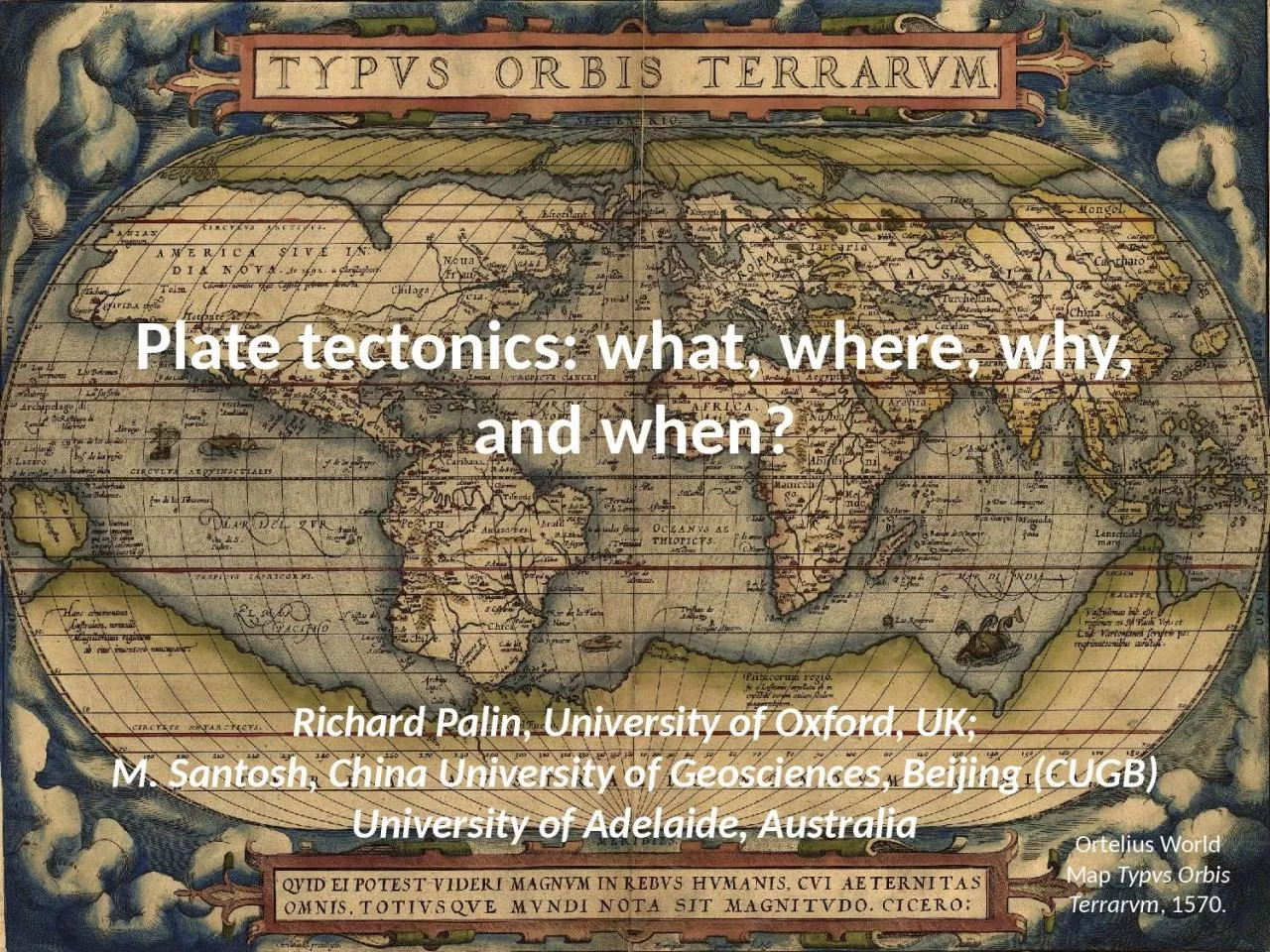

Richard Palin University of Oxford UK M Santosh China University of Geosciences Beijing CUGB University of Adelaide Australia Ortelius World Map Typvs Orbis Terrarvm 1570 Culmination of centuries of research ID: 1021059
Download Presentation The PPT/PDF document "Plate tectonics: what, where, why, and w..." is the property of its rightful owner. Permission is granted to download and print the materials on this web site for personal, non-commercial use only, and to display it on your personal computer provided you do not modify the materials and that you retain all copyright notices contained in the materials. By downloading content from our website, you accept the terms of this agreement.
1. Plate tectonics: what, where, why, and when?Richard Palin, University of Oxford, UK;M. Santosh, China University of Geosciences, Beijing (CUGB)University of Adelaide, AustraliaOrtelius World Map Typvs Orbis Terrarvm, 1570.
2. Culmination of centuries of research16th century – Atlantic coastlines18th/19th century – catastrophism to uniformitarianism (Hutton/Lyell)1912 – Wegener’s compendium of evidence for continental drift1928 – radioactive decay and mantle convection (Holmes)1940s/1950s – palaeomagnetism and changing pole positions1962 – geophysics, mapping, and sea floor spreading (Hess)Formalization and widespread acceptance of the plate tectonic paradigm in 1969 at the Geological Society of America Penrose Conference, Pacific Grove, California“The Meaning of the New Global Tectonics for Magmatism, Sedimentation, and Metamorphism in Orogenic Belts”> EGU 2021 - Virtual2Birth of a paradigmhttps://en.wikipedia.org
3. What defines a plate tectonic regime?> EGU 2021 - Virtual3Fischer and Gerya (2016) Gond. Res.Lithosphere can be distinguished from underlying asthenosphere in several waysComposition, rheology, dominant mode of heat flowBehavior of the lithosphere splits regimes into stagnant and mobile end membersStagnant → lid velocity << internal velocity; vice versa for mobile lid regimeCrust is recycled into the mantle in both regimes, but in different waysN.B.! Many forms of stagnant lid regime (may) exist, as shown by geodynamic modelling and observations of the surfaces of rocky bodies in our solar system
4. Many forms of tectonic activity documented in our solar systemIo – heat pipe tectonicsEuropa – icy plates with MOR- and SZ-like featuresVenus and Mars – various stagnant lid features and plume-driven volcanismExoplanets2D/3D geodynamic model predictions cut both ways!Atmospheric analyses?> EGU 2021 - Virtual4Where does plate tectonics operate?“Where” may be equally phrased as “when” if discussing planets other than EarthCould Venus have transitioned into a PT regime, and then back out again?Global resurfacing at c. 300 Ma has erased almost all evidenceStern et al.(2018) GSF
5. Surprisingly well understood, at least in terms of major driving forcesMuch fine detail yet to be resolved, such as how subduction zones initiateObservation and geophysical modelling of relationships between key parametersFSP (and other forces) must change through time due to mantle cooling and secular change in composition of oceanic crust (e.g. Weller et al., 2019; EPSL)> EGU 2021 - Virtual5Why does plate tectonics occur?Forsyth and Ueyda (1975) Billen (2008) Ann. Rev. Earth Sci
6. When did plate tectonics begin on Earth?> EGU 2021 - Virtual6Palin and Santosh (2021)Gondwana Research
7. When did plate tectonics begin on Earth?> EGU 2021 - Virtual7Palin et al. (2020) defined four types of evidence for operation of plate tectonicsBut, be careful! Isolated evidence of subduction is not proof of global PTPetrologicalRocks that form only in convergent margin settingsTectonicIndependent plate motion or rotation, or specific orogenic architecturesGeochemical/isotopicE.g. C or N isotopes in diamondsModelingPalin and Santosh (2021)Gondwana ResearchPetrological or geodynamic (e.g. can plates subduct coherently at high TP?)
8. When did plate tectonics begin on Earth?> EGU 2021 - Virtual8When compiling all independent datasets, a coherent story begins to emergeI’m sure this summary won’t be contentious, at all…!Palin and Santosh (2021) Gondwana Research
9. Acasta Gneiss Complex, Slave Craton, CanadaGranitic orthogneiss with metamorphic ages of c. 4.02–3.6 Ga (e.g. Stern and Bleeker, 1998)Nuvvuagittuq greenstone belt, Québec, Canada“Faux amphibolite” with 146Sm–142Nd isochron age of c. 4.28 Ga (O’Neil et al., 2008)Hadean zirconsJack Hills area of the Archean Narryer Terrane, W. Australia (e.g. Wilde et al., 2001)Age peaks at c. 3.3 Ga and 4.1 Ga> EGU 2021 - Virtual9Earth’s oldest crystals and Earth’s oldest crustMarchi et al. (2014) NatureVarious isotopic, geochemical, and mineral inclusion features suggest subduction
10. > EGU 2021 - Virtual10Invited review for upcoming Centennial Volume (to be published at end 2021)